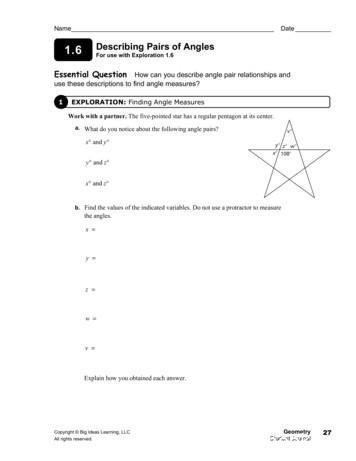1.6 Describing Pairs Of Angles
NameDateDescribing Pairs of Angles1.6For use with Exploration 1.6Essential Question How can you describe angle pair relationships anduse these descriptions to find angle measures?1EXPLORATION: Finding Angle MeasuresWork with a partner. The five-pointed star has a regular pentagon at its center.a. What do you notice about the following angle pairs?x and y v y z w x 108 y and z x and z b. Find the values of the indicated variables. Do not use a protractor to measurethe angles.x y z w v Explain how you obtained each answer.Copyright Big Ideas Learning, LLCAll rights reserved.GeometryStudent Journal27
Name Date1.62Describing Pairs of Angles (continued)EXPLORATION: Finding Angle MeasuresWork with a partner. A square is divided by its diagonals into four triangles.a. What do you notice about the following angle pairs?a and b c and d e d c c and e b b. Find the values of the indicated variables. Do not use aa protractor to measure the angles.c d e Explain how you obtained each answer.Communicate Your Answer3. How can you describe angle pair relationships and use these descriptions to findangle measures?4. What do you notice about the angle measures of complementary angles,supplementary angles, and vertical angles?28GeometryStudent JournalCopyright Big Ideas Learning, LLCAll rights reserved.
Name1.6DateNotetaking with VocabularyFor use after Lesson 1.6In your own words, write the meaning of each vocabulary term.complementary anglessupplementary anglesadjacent angleslinear pairvertical anglesCore ConceptsComplementary and Supplementary AnglesCA115 20 170 2B 1 and 2 A and Bcomplementary anglesTwo positive angles whose measures havea sum of 90 . Each angle is the complementof the other.65 3 4 3 and 4D C and Dsupplementary anglesTwo positive angles whose measures have asum of 180 . Each angle is the supplementof the other.Notes:Copyright Big Ideas Learning, LLCAll rights reserved.GeometryStudent Journal29
Name Date1.6Notetaking with Vocabulary (continued)Adjacent AnglesComplementary angles and supplementary angles can be adjacent angles or nonadjacentangles. Adjacent angles are two angles that share a common vertex and side, but haveno common interior points.common side5768common vertex 5 and 6 are adjacent angles 7 and 8 are nonadjacent angles.Notes:Linear Pairs and Vertical AnglesTwo adjacent angles are a linear pair whentheir noncommon sides are opposite rays. Theangles in a linear pair are supplementary angles.Two angles are vertical angles whentheir sides form two pairs of oppositerays.common side31 2noncommon side noncommon side 1 and 2 are a linear pair.456 3 and 6 are vertical angles. 4 and 5 are vertical angles.Notes:30GeometryStudent JournalCopyright Big Ideas Learning, LLCAll rights reserved.
Name DateNotetaking with Vocabulary (continued)1.6Extra PracticeIn Exercises 1 and 2, use the figure.P1. Name the pair(s) of adjacent complementary angles.LKT15 15 2. Name the pair(s) of nonadjacent supplementary angles.Jm A 36 . Find m B.QR105 MIn Exercises 3 and 4, find the angle measure.3. A is a complement of B andS105 75 O75 4. C is a supplement of D andm D 117 . Find m C.In Exercises 5 and 6, find the measure of each angle.5.6.AB(10x 22) CE(6x 5) HF (12x 5) (7x 34) DGIn Exercises 7 –9, use the figure.7. Identify the linear pair(s) that include 1.148. Identify the vertical angles.9. Are 6 and 7 a linear pair? Explain.Copyright Big Ideas Learning, LLCAll rights reserved.235106978GeometryStudent Journal31
Adjacent angles are two angles that share a common vertex and side, but have no common interior points. 5 and 6 are adjacent angles 7 and 8 are nonadjacent angles. Notes: Linear Pairs and Vertical Angles Two adjacent angles are a linear pair when Two angles are vertical angles when their noncommon sides are opposite rays.
Joel Singer of Santa Clara CA and Michael Cohen See 0–1500, page 3 See 0–5000, page 2 Chip Dombrowski, editor editor@acbl.org Mark Aquino Jonathan Green Shelley Burns Kelvin Raywood Garry & Rona Goldberg Premier Pairs start today The NAOBC Premier Pairs, 0–5000 Pairs and 0–1500 Pairs
In practice, pairs trading contains three main steps5: Pairs selection: identify stock pairs that could potentially be cointegrated. Cointegration test: test whether the identified stock pairs are indeed cointegrated or not. Trading strategy design: study the spread dynamics and design proper trading rules. 5G. Vidyamurthy, Pairs Trading .
AP Statistics Semester One Review Part 1 Chapters 1-5. AP Statistics Topics Describing Data Pr oducing Data Pr obability Statistical Inf er ence. Describing Data Ch 1: Describing Data: Gra phicall y and Numericall y Ch 2: The Normal Distributions Ch 3: Describing BiV a
Innova Dryer for shoes, boots and gloves 55-102-400 Shoe and boot dryer for 5 pairs 30 x 54 x 215 30 550/1100 55-102-390 Shoe and boot dryer for 10 pairs 60.5 x 54 x 215 50 1050/2100 55-102-401 Shoe and boot dryer for 15 pairs 90 x 54 x 215 70 1100/2200 55-102-391 Shoe and boot dryer for 20 pairs 120.5 x 54 x 215 90 1575/3150
(B) Note that the rope is constructed of eight strands arranged in four strand pairs. Four strands (two strand pairs) rotate to the right, shown here in gray. Rotate 900 (with the standing part as the axis) and note the remaining four strands (two strand pairs) rotate to the left, shown below in white. (C) In making the splice, it is important to remember that the right-laid strand pairs of .
Unit 4 Review Congruent Triangles 1. Name all the pairs of corresponding angles. _ 2. Name all the pairs of vertical angles. _ 3. Name all the pairs of alternate interior angles. _ 4. Name all the pairs of alternate exterior angles. .
Forces act on objects so the arrow must touch the object in the diagram. Interaction pairs Forces always come in pairs. The pairs are called interaction pairs. In the diagram of the tennis ball sitting on the table: Gravity pull
The DNA packaging problem-E. Coli: 1X 1 million base pairs (Chlamydia trachomatis)-Yeast genome: 12X 12 million base pairs-Fruit fly genome: 122X 122 million base pairs-Human genome: 3400X 3.4 billion base pairs. If our strands of DNA were stretched out in a line, the 46 chromosomes making























